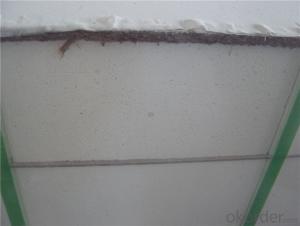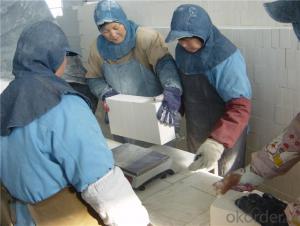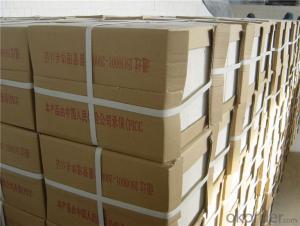Furnance Fireproof Insulation Fire Brick/ Fire Clay Brick
- Loading Port:
- Shanghai
- Payment Terms:
- TT OR LC
- Min Order Qty:
- 1 m.t.
- Supply Capability:
- 1000 m.t./month
OKorder Service Pledge
OKorder Financial Service
You Might Also Like
Thermal Insulation Fire Clay Brick
Refractory brick is a block of refractory ceramic material used in lining furnaces, kilns, fireboxes, and fireplaces.
We provide high quality Refractory Fire Bricks that are used on wide range in the various industries like Cement, Glass and Steel. Refractory Fire Bricks are provided as per the quantity and specifications required by the customers. We provide an extensive range of Refractory Fire Bricks at reasonable prices that depend upon the quantity ordered.
Application
Insulating Fire Brick are used for the lining of converter, alternating current arc furnace, direct Current arc furnace and the ladle slag line, etc.
Company Advantage
(1)Long Insulating Fire Brick manufacture history: 25 years manufacturer
(2)Advanced equipment
(3)Diversification of production standards: ISO ANSI FEPA JIS ASTM
(4)Flexible payment: T/T L/C D/P D/A
(5)Professional marketing team and after-sale service
Insulating Fire Brick main feature:
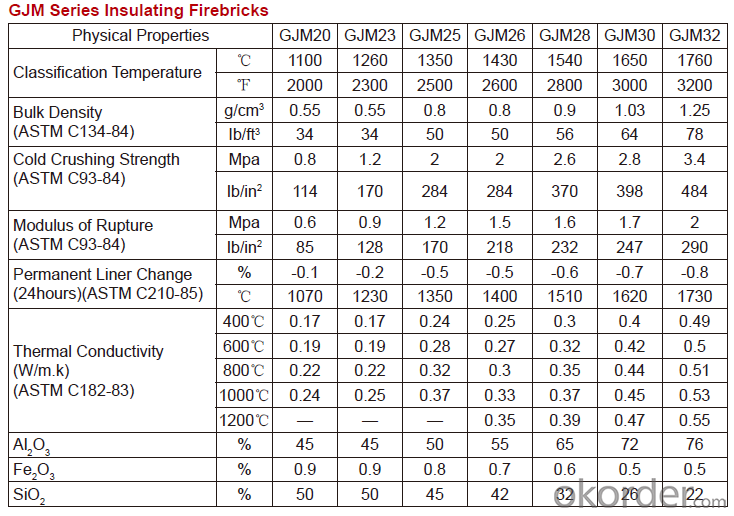
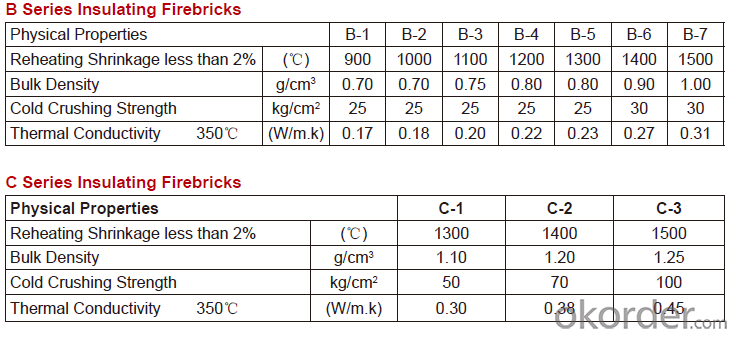
Equipment
1 unit of Ceramic Abrasive (SG Abrasive) pilot production line
2 units of Compact grain Abrasive pilot production lines
1 unit of high-end coated abrasives (abrasive cloth) production line
2 units of Boron Carbide production lines
3 large flexible crushing and sieving lines for grit production lines
6 units of 5000KVA-10000KVA dumping type electric arc furnaces for Brown Fused Alumina fusion
Q1 What’s the transport method?
A1 FCL delivery goods with wooden pallet or wooden case by sea; If LCL delivery, must with wooden case; Sometimes need open top, flat rack or bulk cargo.
Q2 What’s the required payment term?
A2 Generally 30% TT as the prepayment, 70% TT before delivery. If need, 100% Irrevocable Letter of Credit or negotiation.
Q3 Which country are our products exported to?
A3 Apart from entire Chinese market, the US, Russia, Japan, Korea, Australia and some Southeast Asian Nations.
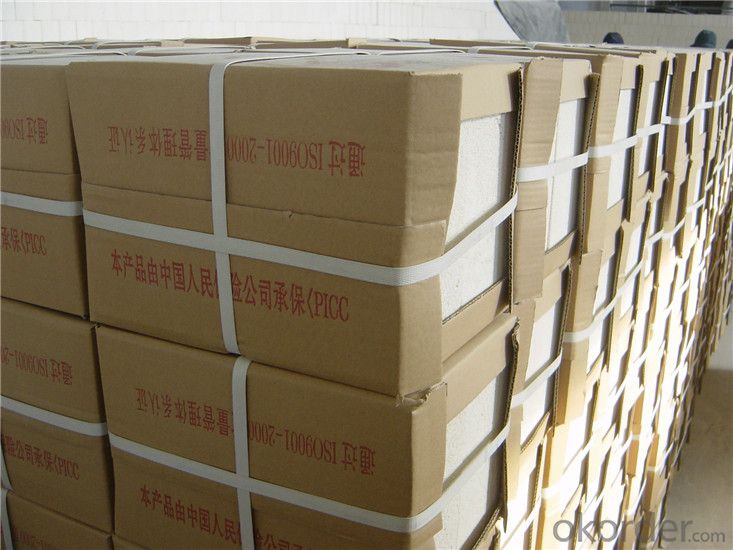

- Q:Can insulating fire bricks be used in cryogenic applications?
- Yes, insulating fire bricks can be used in cryogenic applications. These bricks have low thermal conductivity and are capable of withstanding extremely low temperatures, making them suitable for insulation in cryogenic environments.
- Q:Can insulating fire bricks be used in boilers for steam generation?
- Boilers can utilize insulating fire bricks for steam generation. These bricks are composed of lightweight materials, such as ceramic fibers or expanded clay, that possess exceptional insulation properties. Their low thermal conductivity ensures effective heat transfer prevention. The insulation within boilers is crucial for minimizing heat loss and enhancing energy efficiency. Insulating fire bricks can be utilized to line the boiler combustion chamber's walls, roof, and floor. By creating a highly insulating barrier, they retain heat within the chamber, enabling more efficient steam generation. Additionally, insulating fire bricks possess the ability to withstand high temperatures, making them suitable for boilers that involve elevated temperature steam generation. They also exhibit resistance to thermal shock, which is significant in scenarios where temperature fluctuations can arise. In conclusion, insulating fire bricks offer considerable advantages for boiler applications. They provide exceptional insulation, can endure high temperatures, and contribute to enhanced energy efficiency in steam generation.
- Q:Can insulating fire bricks be used in metal smelting furnaces?
- Yes, insulating fire bricks can be used in metal smelting furnaces. These bricks are designed to withstand high temperatures and provide excellent insulation, making them suitable for use in furnaces where metal smelting occurs. They help maintain consistent heat levels and reduce heat loss, allowing for efficient and effective metal smelting processes.
- Q:Can insulating fire bricks be used in the construction of lime production molds?
- Yes, insulating fire bricks can be used in the construction of lime production molds. Insulating fire bricks are designed to have high thermal resistance, making them ideal for applications that require insulation and protection from high temperatures. Lime production molds often involve high temperatures during the firing process, and insulating fire bricks can help maintain the desired temperature and prevent heat loss. Additionally, the insulating properties of these bricks can help reduce energy consumption and improve the efficiency of the lime production process. Therefore, using insulating fire bricks in the construction of lime production molds is a suitable choice.
- Q:Can insulating fire bricks be recycled?
- Yes, insulating fire bricks can be recycled. These bricks are typically made from a combination of materials such as clay, alumina, and silica, which can be broken down and reused. Recycling insulating fire bricks involves crushing them into smaller pieces and then using them as aggregate in various construction applications. This process helps to reduce waste and conserve resources, making it an environmentally friendly option for disposing of these bricks. Additionally, some companies offer recycling programs specifically for insulating fire bricks, allowing individuals and businesses to easily recycle them instead of sending them to landfills.
- Q:Can insulating fire bricks be used for insulation in power plants?
- Insulating fire bricks have proven themselves to be effective for insulation purposes in power plants. These bricks are specifically designed to possess exceptional thermal insulation properties, making them highly suitable for applications involving high temperatures. They can endure extreme temperatures and effectively insulate power plant operations, thus preventing heat loss and enhancing energy efficiency. In power plants, insulating fire bricks find extensive usage in various areas, including furnaces, boilers, kilns, and chimneys. They can be utilized to line the walls, floors, and roofs of these structures, aiming to minimize heat transfer and maintain optimal temperatures within the equipment. The utilization of insulating fire bricks in power plants offers numerous benefits. These bricks aid in reducing heat loss, enhancing combustion efficiency, and alleviating thermal stress on the equipment. They create a barrier against heat transfer, thereby conserving energy and minimizing operational expenses. Moreover, their insulation properties contribute to a safer working environment for power plant personnel. Nevertheless, it is important to exercise caution when selecting insulating fire bricks for power plant insulation. The specific requirements and conditions of the power plant should be carefully considered. Factors such as operating temperature, exposure to chemicals, and mechanical stress should be taken into account to ensure that the bricks are capable of withstanding harsh conditions and delivering long-lasting insulation performance.
- Q:Are insulating fire bricks resistant to flame impingement?
- Yes, insulating fire bricks are resistant to flame impingement.
- Q:Are insulating fire bricks suitable for use in high-temperature chimneys?
- Yes, insulating fire bricks are suitable for use in high-temperature chimneys. These bricks are designed to withstand extreme heat, making them an ideal choice for insulation purposes in chimneys where temperatures can reach high levels. Insulating fire bricks provide excellent thermal resistance and insulation properties, ensuring the safety and efficiency of high-temperature chimneys.
- Q:Can insulating fire bricks be used in wood-fired kilns?
- Yes, insulating fire bricks can be used in wood-fired kilns. Insulating fire bricks are specifically designed to withstand high temperatures and provide insulation, making them suitable for use in wood-fired kilns where temperatures can reach extreme levels.
- Q:Can insulating fire bricks be used in high-temperature insulation blankets for aerospace applications?
- Insulating fire bricks are not typically used in high-temperature insulation blankets for aerospace applications due to their solid and rigid nature, which makes them unsuitable for flexible and conformable insulation. Instead, aerospace insulation blankets are typically made from flexible and lightweight materials like ceramic fiber or silica fiber. These materials offer excellent thermal insulation properties and can easily mold and shape to fit complex geometries. They provide effective heat insulation and protection for critical components. Additionally, insulation blankets in aerospace applications must meet stringent requirements such as low outgassing, high thermal stability, and resistance to vibration and mechanical stress. Insulating fire bricks may not satisfy these specific requirements and may not withstand the extreme conditions in aerospace environments. In conclusion, while insulating fire bricks excel in certain high-temperature insulation applications, they are not appropriate for aerospace insulation blankets. The aerospace industry demands insulation materials that are flexible, lightweight, and high-performing, capable of conforming to intricate shapes and enduring the unique challenges of this sector.
1. Manufacturer Overview |
|
|---|---|
| Location | |
| Year Established | |
| Annual Output Value | |
| Main Markets | |
| Company Certifications | |
2. Manufacturer Certificates |
|
|---|---|
| a) Certification Name | |
| Range | |
| Reference | |
| Validity Period | |
3. Manufacturer Capability |
|
|---|---|
| a)Trade Capacity | |
| Nearest Port | |
| Export Percentage | |
| No.of Employees in Trade Department | |
| Language Spoken: | |
| b)Factory Information | |
| Factory Size: | |
| No. of Production Lines | |
| Contract Manufacturing | |
| Product Price Range | |
Send your message to us
Furnance Fireproof Insulation Fire Brick/ Fire Clay Brick
- Loading Port:
- Shanghai
- Payment Terms:
- TT OR LC
- Min Order Qty:
- 1 m.t.
- Supply Capability:
- 1000 m.t./month
OKorder Service Pledge
OKorder Financial Service
Similar products
New products
Hot products
Related keywords
